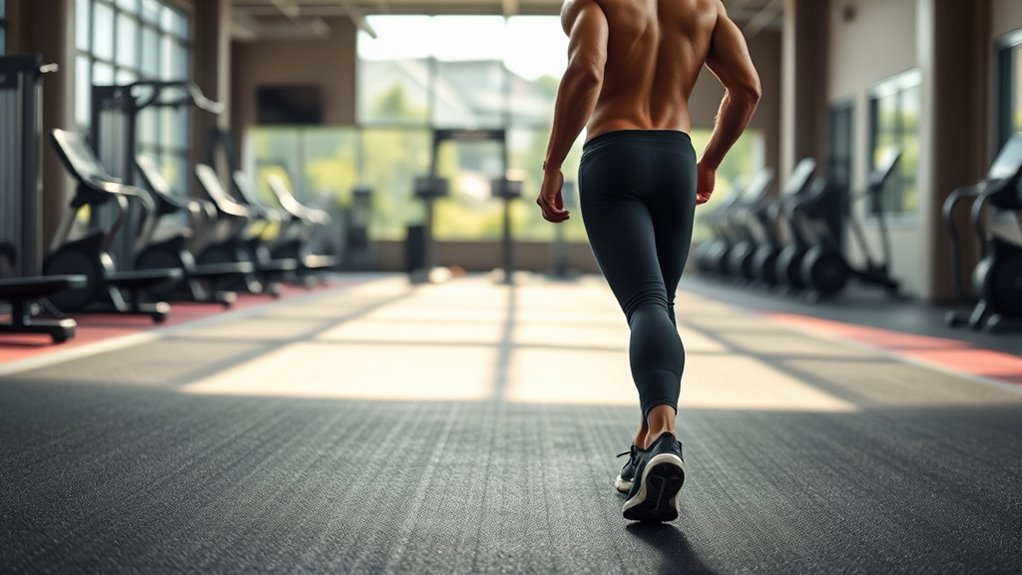Walking backward is trending in functional fitness because it targets muscles like your calves, hamstrings, and glutes in a new way, helping to boost strength and stability. It challenges your balance, coordination, and proprioception, which can improve your overall movement and reduce injury risks. Plus, it’s simple, equipment-free, and easy to incorporate into warm-ups or cool-downs. Keep exploring, and you’ll discover how this movement can transform your fitness routine even further.
Key Takeaways
- It activates different muscles, enhancing overall strength and stability for functional movements.
- Improves balance, coordination, and proprioception, reducing injury risk in daily activities.
- Offers a low-impact way to diversify workouts, making fitness routines more engaging.
- Strengthens stabilizer muscles, supporting joint health and injury prevention.
- Supports rehabilitation and muscular balance, contributing to safer, more effective functional training.

Have you ever considered walking backward as part of your fitness routine? It might seem a little unusual at first, but this simple change can make a significant difference in your overall training. Walking backward isn’t just a quirky trend; it’s a powerful tool for improving balance training and injury prevention. When you walk backward, you engage different muscle groups than you do when walking forward. Your calves, hamstrings, and glutes work harder to control your movement and stabilize your body. This enhanced muscle engagement helps strengthen your lower limbs, making you more resilient during everyday activities and other workouts. Plus, it challenges your coordination and proprioception—the sense of knowing where your body is in space—which is vital for maintaining good balance. Better balance training translates into fewer falls and less strain on your joints, reducing your risk of injuries over time.
Incorporating backward walking into your routine can be surprisingly easy. Start on a flat, even surface like a track or a gym floor, where you feel safe and confident. Keep your posture upright, look ahead (not down at your feet), and take small, controlled steps. As you become more comfortable, gradually increase your pace and distance. Walking backward activates muscles in a different way, encouraging your body to adapt and strengthen its stabilizers. This variation can help prevent overuse injuries that often stem from repetitive forward movements. Many athletes and trainers have turned to backward walking precisely because it offers these injury prevention benefits. It’s especially helpful if you’re recovering from a lower limb injury or looking to build a more balanced physique. Additionally, integrating retirement planning strategies into your financial habits can provide long-term security and peace of mind, much like building balanced strength for your body.
You don’t need fancy equipment to get started. All you need is a safe space and a bit of awareness. Incorporate backward walking into your warm-up to activate your muscles and prepare your body for more intense exercises. Alternatively, add it as a cool-down to stretch and strengthen muscles that might not get as much attention during your regular workout. Over time, you’ll notice improvements not just in your balance, but also in your overall coordination and muscular endurance. Because it encourages proper alignment and control, walking backward can help correct imbalances and reduce the likelihood of injury during other physical activities. Ultimately, this simple movement adds variety to your fitness routine, keeps your muscles engaged in new ways, and supports your goal of staying injury-free while building strength and stability.
Frequently Asked Questions
Does Walking Backward Improve Coordination Better Than Forward Walking?
Walking backward can considerably boost your coordination enhancement and balance improvement. Unlike forward walking, it challenges your body’s stability and neuromuscular control, forcing you to adapt quickly. This movement engages different muscles and proprioceptors, helping you develop better overall coordination. So, yes, walking backward may improve your coordination more effectively than forward walking, especially when incorporated into a balanced fitness routine. Give it a try to see the benefits firsthand.
Are There Specific Health Conditions That Benefit Most From Backward Walking?
You might find that backward walking benefits those with arthritis relief and balance enhancement. If you have joint pain or stiffness, this low-impact exercise can reduce pressure on your knees and hips, easing discomfort. Additionally, it improves your balance and stability, helping prevent falls. People with certain health conditions like Parkinson’s disease or balance issues often see positive results, making backward walking a valuable addition to their fitness routines.
How Does Backward Walking Impact Knee Joint Health Long-Term?
Did you know that backward walking can reduce knee joint stress by up to 20%? Long-term, this activity promotes cartilage preservation by encouraging different muscle engagement and joint alignment. You’ll strengthen stabilizers around your knee, improving joint resilience. As a result, you may experience less wear and tear, reducing the risk of osteoarthritis. Incorporating backward walking into your routine supports healthier knee joints and enhances overall functional mobility.
Can Beginners Safely Incorporate Backward Walking Into Their Routines?
As a beginner, you can safely incorporate backward walking into your routine by focusing on proper technique and starting slowly. Make sure to wear supportive shoes and walk in a flat, obstacle-free area. Pay attention to your posture, and begin with short distances, gradually increasing as your balance and confidence improve. Prioritize beginner safety to prevent injuries and ensure you gain the benefits of this effective exercise.
What Equipment Is Recommended for Safe Backward Walking Practice?
Ever imagined yourself confidently walking backward without slipping? To guarantee safety, you should consider using ankle resistance bands to strengthen your muscles and enhance control. Balance mats are also helpful, providing stable footing and reducing risk of falls. These tools support proper technique and build confidence, making your backward walking practice both safe and effective. Are you ready to take your functional fitness to the next level?
Conclusion
So, next time you lace up, consider stepping backward. It’s like rewinding to rediscover your strength, a dance with your muscles that sparks new energy in your routine. Walking backward isn’t just a trend; it’s a journey back to your body’s potential, revealing hidden power with every step. Embrace the backward walk, and watch as your fitness story rewrites itself, turning obstacles into opportunities and every stride into a step toward greatness.








